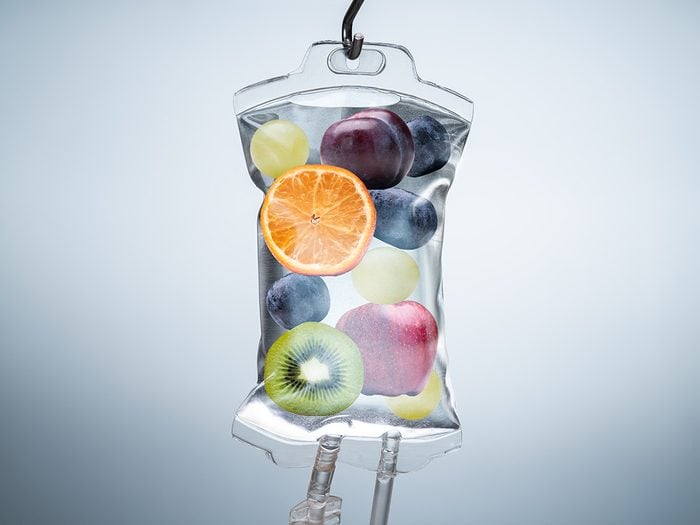I Got an IV Drip to See If It Could Boost My Energy Levels

Here's how it went.
When I signed up for my first appointment at an IV bar, I was a few weeks out from having COVID for the first time, and I still felt bone-tired. Thankfully, everyone in my family had experienced a mild case, but as many of us now know, it’s hard to gauge what is “normal” post-COVID fatigue, and what is just the general exhaustion of life with small children when you’re nearing 40 and well into the third year of a pandemic. I mean, who couldn’t use a little energy boost every now and then? The possibility of a little more pep in my step was pretty enticing, and I was curious.
The clinic I booked, the IV Lounge, was reassuringly medical. I was expecting something more akin to a fancy Yorkville juice bar or salon, but it was really more like a physiotherapist’s office or a blood lab. The treatment chairs are big and comfy with fluffy pillows, and they had Netflix playing on a large TV. But the accoutrements are 100-percent medical: boxes of latex gloves, biohazard bins for needles and hospital-like curtains separating each chair. The most jarring part of the experience, for me, was the parade of my fellow patients (customers? clients?) wandering down the hallways with their rattling IV poles, headed for the washroom.
That’s the thing with these treatments: they promise hydration, and boy, do they deliver. Many of my chair-neighbours headed for the loo two or three times in the one to two hours it took for our IV drips to make it through the tubing and into our arms. I had never had an IV before, and was too nervous to move around with it stuck in my arm, but as soon as my bag was empty, I raced to the bathroom. And—TMI alert—my pee was extremely yellow and smelly—a sign that my body was eliminating excess vitamins.
While I didn’t need any bloodwork before I got my IV, the health history forms I had to fill out in advance of my appointment were extensive, which put me somewhat more at ease. My consult with naturopath Amauri Caversan prior to my treatment lasted over an hour. I’ve always been skeptical of holistic medicine and had never met with a naturopath before, and I was surprised by the level of care and attention I received compared to the one-issue-per-10-minute-appointment approach that’s more typical of busy family doctors. (And Caversan did encourage me to get bloodwork done and share the results with him, going forward.)
He checked my blood pressure, then selected a custom mix for me: combining the “relaxation IV treatment” (“nootropic amino acids and minerals”) with the “max hydration drip” (a “nourishing blend of vitamins, minerals and electrolytes … formulated to help restore fluids, while rehydrating and detoxifying the body”). The ingredients listed on my printed receipt included vitamin C, B complex, calcium chloride, magnesium sulfate, niacinamide, riboflavin, sodium bicarbonate, selenium, zinc, mixed aminos, taurine, glycine, tryptophan and lactated Ringer’s (which is a rehydrating IV fluid that’s used as an alternative to saline—a mixture of sodium chloride, sodium lactate, potassium chloride and calcium chloride in water). Obviously, most people would need a chemistry or biology class refresher to make sense of that list.
I genuinely enjoyed my two hours of relaxing in the chair, watching Netflix and scrolling my phone while hooked up to the IV. It only pinched a bit, the fluid flowing into my veins felt only a teensy bit chilly (a common complaint) and I felt very safe in a sterile, clean environment with a nurse checking in periodically. (She even brought me snacks!)
But in the days following my treatment, unusually vibrant urine was pretty much the only change I noticed; I didn’t feel energized or refreshed. A follow-up email from the clinic told me that’s normal—some clients won’t see improvements until they’ve paid for several more visits (of course).
While I don’t think I’ll ever go back for another IV, I can see the appeal, especially for those who feel they haven’t been heard or helped by the conventional medical system. Many of us just want to feel seen and to have our concerns validated.
“A lot of times people are frustrated,” says Michelle Cohen, a family doctor who studies alternative health trends. “Because they’ve been to their doctor, they’ve described a problem, and there hasn’t been a clear diagnosis. And then someone else is saying, ‘Well, hey, I’ve got a simple treatment for you—and you’re gonna feel much better.’ So I’m very empathetic to what drives people to seek out this kind of treatment.
“That’s a very compelling thing—that desire to feel better.”
Next: Can IV Drips Really Help Treat Your Fatigue, Low Vitamin Levels and Hangover?




